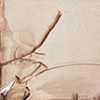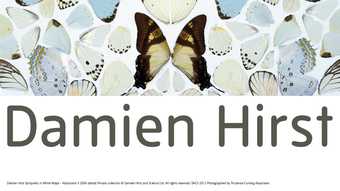The sheer volume of recent writings and academic conferences on the contemporary sublime suggest the subject is very much a matter of current concern.1
But there is also a sense in which the sublime is not ever quite contemporary. To discuss the sublime now, we find ourselves inevitably tracing our way back to a historical discourse, to eighteenth-century thinkers such as Edmund Burke and Immanuel Kant who theorised sublimity in its ‘classic’ form, or to nineteenth-century artists such as Caspar David Friedrich or J.M.W. Turner, with whom the aesthetic of the sublime is tightly associated. In fact, the very eighteenth-century thinkers who developed the notion of the sublime in its familiar, modern form were already looking back to the ancient world and to Longinus, and thus found themselves already caught up in the untimeliness of the idea.2
Such a notion of a ‘contemporary sublime’ thus seems to me to raise two closely linked questions. First: what does it mean for the sublime to be at once a matter of current concern, but also a very old idea? And second: what is the relationship between the sublime that cultural historians of the eighteenth century studied and the sublime now?
Answering these questions is complicated by the peculiarly intermittent unfolding of the history the sublime, which has cycled repeatedly between being a key aesthetic or critical idea and becoming something seemingly irrelevant and outmoded, rising from its grave repeatedly, like those movie-monsters who are never quite killed off because they are already (un)dead. This insistent repetition of the sublime – like the return of the repressed – involves us in the temporality that Freud called Nachträglichkeit (sometimes translated as ‘afterwardsness’). Entwined as it is with a temporality of return, I understand the ‘contemporary sublime’ as a matter of our culture’s haunting by the history of sublimity. In such Freudian terms, haunting and Nachträglichkeit speak in turn of trauma; and the trauma that I would argue lies at the heart of this haunting is the rise of the capitalist modernity in which, as Marx’s translators put it, ‘all that is solid melts into air’, a phrase itself redolent with alchemical notions of sublimation.3
After all, parallel to the aesthetic revolution of the sublime ran the ‘financial revolution’ of the 1680s to 1750s.4
If we find ourselves tangling with the sublime again today, the reason for this might be our embrace within a capitalist modernity whose form of capital has come once more to bear uncanny resemblances to the imperial, hyper-liquid and perplexingly spectral capital of the eighteenth century.
To trace one aspect of this haunted present, I shall focus here on the natural sublime. A key aspect of the recent resurgence of the sublime as a subject for study has undoubtedly been its relevance as an aesthetic of terrible nature, at a moment when, with growing fears about environmental catastrophe, nature has reappeared as a limit to human power, progress and wealth, something which even threatens to destroy us. However, the approach I have outlined above implies that such representations of nature may be intimately bound with anxieties about capitalism. It is, in particular, the transfiguration of the natural world in early modernity by developing capitalist practices which, I suggest, is key in making sense of the sublime both then and now.
Hirst’s shark
My starting place for tracing such returns of the natural sublime is Damien Hirst’s art work, The Physical Impossibility of Death in the Mind of Someone Living 1991 (fig.1). This is not to propose that the work is ‘sublime’ in some affirmative sense, nor to imply that Hirst has an environmentalist agenda. He is not taken up here as an exemplary artist, but rather a symptomatic one, who tells us much about our own time. Thus, Hirst’s art, riven with the contradictions of our society, is rather like capital’s uneasy dream-image of itself. His best work condenses our lived contradictions into perplexing, unforgettable, iconic images, in just the way that dreams do.
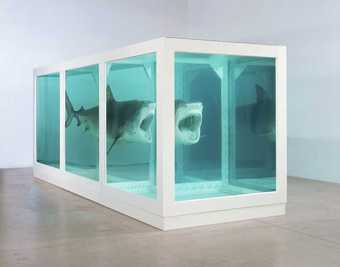
Fig.1
Damien Hirst
The Physical Impossibility of Death in the Mind of Someone Living 1991
Glass, steel, silicon, formaldehyde and shark
2170 x 5420 x 1800 mm
Photograph: Prudence Cuming Associates
© Damien Hirst. All rights reserved, DACS 2010
The sensibility for the sublime, it would seem to me, plays an important role in the formation of these images, and Hirst’s work is a locus where the histories of sublimity haunt contemporary culture. It often appears as if he has taken Burke’s treatise on the sublime as a handbook for cultural production (which, of course, is exactly what it was). Hirst echoes Burke’s fascination, for example, with the body, mortality, violence, pain and power. For Burke, such effects elicit ‘the strongest emotion which the mind is capable of feeling’,5
and it is in these terms that he defines the sublime. Hirst, too, orients his production towards this maximum of affect. In this context, Hirst’s restaging of the Burkean sublime places him in a long tradition of the commercial exploitation of the tropes and themes of the sublime. This tradition of the commercialised sublime places Hirst as much in the company of the Hollywood blockbuster, with its concern for overawing its spectators, as it writes him into a history of the avant-garde. Hirst’s shark is more Steven Spielberg than it is Barnett Newman.6
The afterlife of the sublime for Hirst, then, is a means to push his audience’s buttons. Hirst has thus spoken of his interest in the shark, for the ‘really powerful kind of horror’7
that it produces, and as a ‘universal trigger’. During an interview he stated that ‘everyone’s frightened of sharks, everyone loves butterflies’.8
But though the shark is certainly for us a powerfully charged image, carrying the frisson of the Burkean sublime, it is not, as Hirst seems to suggest, simply a matter of ‘universal’ human responses. Rather, the figure of the shark as we recognise it today is also a peculiarly modern invention; its charge is tightly bound up with the transformation of ideas of nature as these developed alongside the emergence of capitalism and the sublime. If we turn to the ancient world, and to Pliny’s description of the shark in his Natural History, we find a very different beast from the one lodged in the modern imagination. Pliny writes:
Divers have fierce fights with the canis marinus; these attack their loins and heels and all the white parts of the body. The one safety lies in going for them and frightening them by taking the offensive, for the canis marinus is as much afraid of a man as a man is of it.9
This fish is certainly fierce and dangerous, but is far from being the inhuman monster, with those ravening, all-devouring and insatiable jaws, and row upon row of razor sharp-teeth, and with its implacable pursuit of human flesh, that occupies the fantasies of contemporary culture. There is none of Hirst’s ‘powerful kind of horror’ here, which is also to say categorically no sublimity. Even Pliny’s name for this beast, canis marinus or ‘dog of the sea’, which, translated into one language or another, was the primary name used in Europe for sharks throughout the Middle Ages, serves to make this beast familiar, small and ordinary. Only in the sixteenth century did new words appear to describe the shark in European languages: in Spanish, tiburón; in French, requin; and in English shark. These words shed the humdrum connotations of the dog, allowing sharks to be reimagined as terrible monsters of the deep.
What is ‘triggered’ in Hirst’s presentation of the shark, then, is not just primordial fear, but also a complex web of historically produced associations. It is this historical web, which stands as the ground of the sculpture’s possibility, that I want to examine further.
Changing conceptions of nature
The date at which this occurred locates the emergence of the modern conception of the shark within the context of a larger re-figuration of nature itself. This transformation has been charted in Marjorie Hope Nicolson’s Mountain Gloom and Mountain Glory (1959). In this now-classic publication, Nicolson asks how it was that during the seventeenth century rugged mountainous scenery transformed from being almost universally described in terms of the most ugly, disgusting and morally dubious things in the universe – ‘warts’ or ‘wens’ on the landscape, or even ‘buttocks’ sticking up out of it – to become the source of the deep feeling of awe, wonder, and reverence with which we are familiar today.10
She was thus struck with the strange (and sudden) modernity of what seems to us an entirely natural aesthetic response. It is this new experience which would, in the eighteenth century, be theorised through the notion of the sublime.
Nicolson explains this monumental shift in sensibility in terms of a cosmographic revolution centring on new scientific theories: Galileo’s discovery that the earth does not lie at the centre of the solar system, or Descartes’ and Newton’s proposal of an infinite and centreless space, for example, or theories, such as those of Burnet or Agricola, about the earth’s surface being formed through processes of violent change. Very different from the stable, orderly and anthropocentric Ptolomaic cosmos which was the previously dominant model, these visions recast the universe as vast, formless, dynamic and violent, radically displacing humanity from its centre. For writers of the seventeenth century, God was to be sought now not in orderliness, but in the scale and violence of creation. Vast mountains, echoing the characteristics of this new vision of the universe, became privileged sites for its appreciation. When early-seventeenth-century Northern Europeans on the Grand Tour crossed the Alps they perceived them merely as ugly and dangerous, but by the end of the century they found them instead exhilarating, fascinating and sublime.11
Alongside and against Nicolson’s focus on science as causing these changes – which today seems somewhat reductive – I would also like to explore this in terms of the development of pre-industrial capitalism. The cosmographic vision of Milton’s Paradise Lost (1667, republished in 1674) offers us a way of approaching this.
Paradise Lost
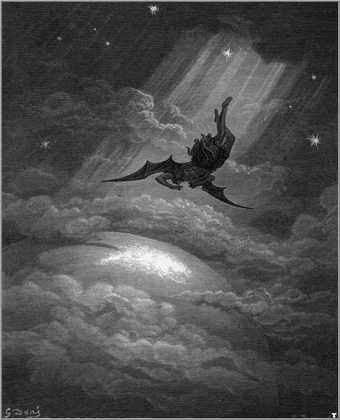
Fig.2
Gustav Doré
Illustration for Paradise Lost 1866
Book 3, lines 739–41
‘Toward the coast of earth beneath, / Down from the ecliptick, sped with hoped success, / Throws his steep flight in many an aery wheel; / Nor staid, till on Niphates’ top he lights.’
Woodcut on paper
Milton’s epic poem was, of course, one of the canonical examples around which eighteenth-century critics developed theories of the sublime.12
Much of its sublimity, I would argue, comes from its powerful articulation of the new universe which Nicolson describes.13
The poem’s vast, formless space resists mapping. Its locations are separated by immeasurable voids of dark, cold space.14
Gustave Doré’s nineteenth-century illustration of Book 3, lines 739–41 of Paradise Lost, in which Satan is traversing these voids makes an admirable attempt to capture something of this quality (fig.2). The poem is characterised by disorienting shifts in scale or perspective, akin to the shock of the new experiences of looking through telescopes and microscopes. But this Miltonic universe, even in its adherence to the new sciences, has also been understood as an articulation of an emerging ‘bourgeois’ ideology, and as an apologia for ‘marketised’ social and political relations. Milton, after all, had served as a propagandist for Oliver Cromwell during the English Civil War. John Rogers thus argues that Milton’s decentred universe drew on new materialist sciences to re-envision, at the level of matter itself, the organisation of a state run not according to the absolute decrees of a divinely instituted monarch, but to an order emerging spontaneously from the interactions of its parts.15
In such a universe, God’s power is distributed atomistically into a vital, active, self-organising matter.16
But Rogers goes on to argue that these vitalist-materialist sciences themselves drew their paradigms of emergent organisation from the nascent discourse of political economy, in the ‘nearly laissez-faire’ writings, for example, of Thomas Mun and Edward Misselden, who were already arguing in the 1620s that that markets functioned most harmoniously when exempt from intrusive monarchic practices of price-fixing.17
It was when left alone by authority, they argued, that goods circulated freely, stimulating a vigorously productive economy. Rogers’s argument is that if Milton’s political ‘proto-liberalism’ is informed by scientific ideas of self-organising matter, these are informed in their turn by an embryonic economic liberalism.
What seems at first problematic with understanding this Miltonic vision of sublime nature as ideology for an embryonic liberalism, is that Milton’s cosmos so often seems a hostile, inhuman place. The matter of this universe often seems to generate not a benevolent order, but rather formless monstrosity. The apotheosis of this darkly sublime principle of Miltonic nature seems, in fact, to be his vision of hell. But ideology, in any case, is always dependent on first raising the very contradiction that it wishes to dispel, and Milton’s poem can thus be understood as shot through with the conflicts which he himself lived but could not fully articulate. Paradise Lost can thus be read as the poetic symptom of the anxieties of an emerging capitalist order.
In the poetry and science of the seventeenth century, then, ‘nature’ is produced through the same abstraction that now mediates social relations, and was already being recognised as eroding older forms of order, value and hierarchy.18
Like capital, nature seemed increasingly formless, mutable, dynamic, and productive of violent upheaval. Nature and capital alike appeared unbounded, unpresentable, and permeated by a purposiveness quite indifferent to human welfare. There is a profound homology between Newton’s infinite, abstract space, which gave birth to innumerable paeans to the sublime vastness of the universe, and the spatial abstractions which Milton’s and Newton’s contemporary William Petty, another father of economics, was putting into practice in the mapping and colonial exploitation of Ireland under the name of ‘political arithmetic’.
Nature, capitalism and the shark
Although this excursion into Milton seems to have moved us away from Hirst’s shark in formaldehyde, I have aimed to sketch the transformed vision of nature in which the peculiarly modern figure of the shark emerges. In Book 2 of Paradise Lost, the fallen angels set out on their own colonial mission, ‘On bold adventure to discover wide / That dismal world, if any clime perhaps / Might yield them easier habitation’. The landscape they encounter (much like that encountered by European colonists in reality) is shifting, extreme and hostile; they find ‘a Universe of death’ (a phrase which Burke picks out for special attention in his account of the sublime)19 in which ‘all life dies, death lives, and Nature breeds, / Perverse, all monstrous, all prodigious things, / Obominable, inutterable, and worse / Than fables yet have feigned’20 (fig.3). The monstrous generation which this landscape produces – a deathly un-creation – marks the zenith of the infernal sublimity of Milton’s universe; and though Milton does not give us any sharks in his poem, we might also recognise the shark, in the form in which it haunts the modern imagination, as just the kind of monster which such a landscape would throw up.21 That such a monstrously generative nature (the kind of nature which would produce the shark) is to be discovered in the context of a fantasy scene of colonisation is itself significant, and a matter to which I shall return shortly.

Fig.3
Gustav Doré
Illustration for Paradise Lost 1866
Book 2, ll.624–7
‘all life dies, death lives, and Nature breeds, / Perverse, all monstrous, all prodigious things, / Obominable, inutterable, and worse / Than fables yet have feigned’.
Woodcut on paper
The shark, I would argue, serves as a hyperbolic example of the terrible sublimity of this new conception of nature. The thrill of such a wild nature is pursued today through the shark in novels, films, wildlife documentaries and extreme tourism. My argument is that the shark provides, throughout its modern history, an image not only of nature as hostile but furthermore, and more precisely, of nature being as rapacious, insatiable, and unfeeling as capital accumulation itself.22
The trope which ties the shark to capitalism has thus been insistent. For a well-known example we need look no further than Steven Spielberg’s film Jaws (1975). Here, the predatory instincts of the shark are mirrored on land by the economic forces that drive the suppression of public knowledge of the shark attacks, so as not to damage profits from the holiday trade. Such a privileging of economic rationality over people’s welfare belies the very name of the seaside town, ‘Amity’, which evokes a pre-modern form of community based on human feeling, an escape from the dysfunctional urban modernity which Police Chief Brody had hoped to leave behind in New York.23
The water lapping at Spielberg’s lens in the beach scenes gives visual form to the contrast between what lies ‘above’ the bright surface of American consumer culture, and the social violence which lurks below.
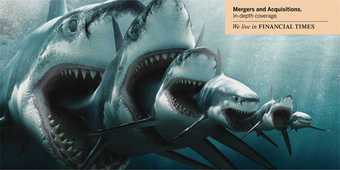
Fig.4
We Live in Financial Times 2008
Advertising campaign
Campaign Agency: DDB UK
Illustrator: Denis Scott
© DDB UK
For further examples, we could certainly trace the way that themes of economic exploitation permeate the genre of the ‘killer shark’ movie.24 But the shark becomes more generally – and repeatedly – a representative figure of capital, even in visual forms which would be far less easily understood as ‘critiques’ of capitalism: in images that might be understood, that is to say, as its own self-presentations. The cover for The Economist (by no means an organ of the subversive left) for 17–23 November 2007, under the headline ‘America’s Vulnerable Economy’, pastiched the famous poster for Jaws, with a female swimmer clad in a stars-and-stripes bikini menaced by a monster shark emerging from the depths beneath her. Even here, in what we would expect to be the most sympathetic of depictions of the processes of capital, these are imagined through the image of the unfeeling, automatic predation of the shark. Similarly, an advertisement displayed in the streets of London on March 2008, for the Financial Times, illustrated ‘in-depth thinking’ about mergers and acquisitions with an image of a chain of ever-larger sharks swallowing their smaller brethren (fig.4). As I prepared this paper, I discovered a further example of the shark being used to sell a financial product in street advertising, this time a Henderson New Star investment fund. On a huge billboard, a diver was pictured next to a shark. The tagline of the advertisement claimed ‘This fund is so flexible [this last word in giant letters] you’re less likely to find yourself in the wrong place’. The fund, then, was being offered as a form of shelter from the perilous waters of the marketplace. But the emphasis of the advertisement on the word ‘flexible’ offers up another, parallel meaning. What was flexible in the image? It was the body of the shark itself, which we know to be lithe, elastic and muscular, and which was depicted curving around towards the poster’s viewer in a sinuous arc. What was on sale here was not just protection, but a piece of ‘shark-like’ financial suppleness – a fund which will eat rather than be eaten.
Race, slavery and colonial exploitation
In mentioning William Petty’s ‘political arithmetic’ above, I have argued for a link between the uses of spatial abstraction for sublime reverie and for colonial exploitation. These also intertwine in the figure of the shark. Petty’s abstract space is reiterated in Hirst’s vitrines, which figure processes of techno-scientific abstraction just as threatening to the living body as the shark itself. In Hirst’s shark, these two forms of violence – natural and technological – seem deliberately intertwined, each serving as a reinforcement of the other. The rationalisation here is now, of course, not that of colonial expropriation, but rather that of the commodification and control of human life in late twentieth-century society. It is the space of the panopticon, the museum, the hospital, and, as Hirst’s The Acquired Inability to Escape (made the same year as Physical Impossibility) makes clear, the office-worker’s prison-like cubicle (fig.5). (Interestingly, Hirst himself, as he worked his way through art college, did time operating the phones for a market research company.) However much this art work may in other respects accommodate itself to the spectacular forms and ideologies of the market, it nonetheless speaks volumes about the experience of being locked within spatio-practical logics of modern, capitalist and technocratic society.

Damien Hirst
The Acquired Inability to Escape
(1991)
Tate
However (and as I have already suggested in my account of the shark as fitting with the monstrously generative Miltonic landscape of hell-as-colonial-outpost), it was largely in relation to that earlier form of imperialist capitalism that the shark first came to figure as an image of the inhumanity of capital. It is, above all, in this context that the shark emerged in the Western imaginary in its specifically modern form, as a monster. The new words which came to name this beast – shark in English and tiburón in Spanish, for example – are imported from languages encountered in the New World, and carry with them the connotations of the new spaces of colonisation.25
These, the blank spaces on the map, were suitable screens for outward projection. The shark was a figure that allowed the violence of social relations to be imagined ‘out there’, at the wild margins of empire, in a hostile nature which ‘over here’ was tamed by civilisation.
James Thomson’s poem, The Seasons (1730), is a case in point. Thomson was a key early eighteenth-century proponent of the natural sublime in poetry, and (to give you some sense of where his politics and his attitude to Empire may have lain), the writer of the lyrics of ‘Rule, Britannia!’ The Seasons, drawing out the imaginary geography of Empire, contrasts the gently bucolic nature of merry England with the sublime and violent nature of the colonial margins. Amongst the best-known of the horrors that he packs into his depiction of the latter is a description of a slave ship which has run into a tropical storm that will destroy it. Pursuing the ship is a shark, waiting to devour the bodies of the men aboard.26
Thomson’s description of the shark runs:
Increasing still the sorrows of those storms,
His jaws horrific arm’d with three-fold fate,
Here dwells the direful shark. Lured by the scent
Of steaming crowds, of rank disease, and death,
Behold! He, rushing, cuts the briny flood,
Swift as the gale can bear the ship along;
And from the partners of that cruel trade,
Which spoils unhappy Guinea of her sons,
Demands his share of prey – demands themselves!
The stormy fates descend: one death involves
Tyrants and slaves; when straight their mangled limbs
Crashing at once, he dyes the purple seas
With gore, and riots in the vengeful meal.27
Thomson here makes much of the shark as a leveller, devouring slave and master alike. Their flesh is reduced to indistinguishable ‘gore’. But this is ideology of course, erasing social difference to disavow the much more particular murderousness of the slave trade, which is now projected outwards onto the shark and into a ‘natural’ order. (We might at this point wonder whether Hirst’s conflation of natural and technological violence also plays something of this role, where the violence of techno-capitalism is imagined as being also part of the prehistoric and even pre-human natural order of predation to which the archaic shark belongs.) But even as this disavowal is performed, the shark itself is nonetheless described in Thomson’s poem metaphorically as a capitalist. It is a ‘partner’ in the ‘cruel trade / which spoils unhappy Guinea of her sons’, and one who ‘demands his share of prey’. Like Milton (and Hirst), Thomson cannot entirely escape the anxieties his work may otherwise be understood to serve to disavow.
The shark and the slave, in fact, are often associated in Western culture, in England right from the very first recorded use of the word shark, in a broadsheet of 1569.28
A sixteen-foot shark had been caught off the Dover coast, and was brought to London to be presented as a show in Billingsgate, in a conjunction of money, media interest and exhibitionary spectacle that might remind a contemporary reader of Hirst exhibiting at the Saatchi Gallery or the Royal Academy. The name for this strange, monstrous fish – ‘shark’ – was to be discovered, explained the broadsheet, on the lips of a crew of slavers just returned from the Americas, whose survival of hardships had earned them something of a celebrity status in London that summer. The name ‘shark’ stuck; and so did the special association of the fish with the racialised bodies of the victims of the slave trade, an association lasting well into the twentieth century. As that century was about to dawn, Winslow Homer painted The Gulf Stream (Metropolitan Museum of Art, 1899), depicting a black sailor in a dilapidated boat, surrounded by sharks. In the middle of the century, the plot of Tintin and the Red Sea Sharks (originally published in 1958) revolved around a ring smuggling Africans enslaved whilst on the pilgrimage to Mecca. And still in 1999, a full century after Homer’s painting, in the shark-attack movie Deep Blue Sea, the character played by rap artist L.L. Cool J., in a moment of cinematic reflexivity, can still complain: ‘Brothers never make it out of situations like this!’
In conjunction with this continued association of the shark with slavery, Thomson’s figuration of the shark as a capitalist can be approached through Paul Gilroy’s work on the Black Atlantic.29
Gilroy argues that the experience of the Middle Passage served as a blueprint for capitalist modernity. Slavery would provide the testing ground of a logic where all human life and labour were subject to the calculation of profit.30
Thomson’s shark reducing its victims to homogeneous ‘gore’ thus not only serves to ideologically erase social difference, but also as a powerful image of the reduction of the particularity of the human body to the abstraction of exchange-value.
Visions of global empire, then and now
John Singleton Copley’s Watson and the Shark 1778 (fig.6), which created a ‘sensation’ at the Royal Academy some 219 years before Damien Hirst’ s work, reprised many of Thomson’s themes. It commemorates the salvation from the jaws of a shark, whilst on a slave-trading expedition, of one Brook Watson, then a rising figure in the City of London.31 Like Thomson’s poem, Copley’s painting allows his elite London audience to envision themselves at the heart of the global-colonial network of enterprise from which their wealth was derived, staging a contrast between their own lives and this exotic and dangerous elsewhere. Its depiction of ‘honest Tars’(as one reviewer called them) pulling together to save Watson provides a reassuring image of colonial endeavour. Its disavowal of social difference – echoing Thomson’s – is amplified in the compositional inversion which places Watson, the most socially elevated figure in the painting, at the base of the composition, and a black sailor at its pinnacle.

Fig.6
John Singleton Copley
Watson and the Shark 1778
Oil on canvas
1821 x 2297 mm
National Gallery of Art, Washington
Hirst’s sculpture, I suggest, involves us in an updated version of the fantasy of Thomson and Copley’s global space of empire. The shark in Hirst remains a token of the exotic, fearsome nature of the antipodes, put on display through the power of money, and by the communicational technologies which allow one to have a shark caught on the other side of the world, refrigerated and shipped back to London. We are positioned, like Thomson’s and Copley’s audiences, at the heart of a spider web of wealth and power. This is surely a part of the frisson of pleasure that Hirst offers us.32 This is, of course, not the Whig-liberal Empire of the eighteenth century which formed the context of the development of the sublime in British criticism, but rather the informational, transnational capital of a new kind of globalisation, within the flows of which the London of the 1980s was asserting itself. This globalisation, of course, is no longer based around slavery, but those very different forms of the calculation and control of human labour powers which I have mentioned already in relation to Hirst’s Acquired Inability to Escape. Hirst’s shark, with its imperial sublime, however, allows us to imagine today’s Empire through the schema of its older type.
Nature, now
The nature we meet in Hirst’s art work is transformed, too. If nature in the eighteenth century still seemed a powerful limit to human endeavour, the industrial and technical developments of the nineteenth and twentieth centuries made it seem increasingly less significant. Cultural historian David Nye has charted the development of a ‘technological sublime’, which replaced the natural variety.33 By the 1960s, the sociologist and philosopher Theodor W. Adorno could think of the natural sublime as an ephemeral stage in European aesthetic sensibility, which had quickly lost its power to present humanity with the ‘non-identitical’.34 For the literary critic and political theorist Fredric Jameson, in the 1980s, the natural sublime had been replaced by the sublimity of the ‘second nature’ of the man-made environment, which was what now seemed primarily to face humanity as a terrible and counter-purposive Otherness.35 If, with the growth of late twentieth-century environmental anxieties, nature has been reasserting itself as outside human control, then this is a nature which is now clearly overcoded with the powers of capitalist techno-science to transform it: a ‘third nature’, if you like, which is neither fully cultural nor fully outside of culture, but a hybrid of both.36 This is the ‘techno-nature’ we find in Hirst’s vitrines. It is also more generally omnipresent in contemporary representations of sharks. The sharks we meet in horror films – in Jaws itself, or more recently in movies such as Deep Blue Sea (1999) or Shark Swarm (2008) – are repeatedly the products of human interference with nature.37 It is a commonplace, furthermore, to describe the shark through technological metaphors: Hooper, the marine biologist in Jaws, is typical, calling the shark ‘a perfect engine – an eating machine’. In this regard the notoriously obvious mechanical nature of Spielberg’s ‘shark’ makes a certain kind of a sense in embodying how we imagine such creatures, as at once an absolute of voraciousness but also as hollowed out of desire: empty, subjectless, automatic. Peter Benchley’s novel, on which Spielberg’s movie was based, extends these metaphors in its descriptions of the shark. When it devours its first victim, Benchley, making the shark more machine than fish, describes it as hitting her ‘like a locomotive’.38 In the first description we have of the monster, it is figuratively decomposed not into a unified entity with a will or agency, but rather, a series of organs which communicate with each other through processes ‘transmission’. It is a kind of cybernetic organism, processing data or ‘signals’ (a word which Benchley repeats) from the world outside it. The cybernetic motif is taken up more emphatically later in the book, where the shark is found ‘banking’, registering ‘impulses’, ‘locking on’ to these and ‘homing’ in on them.39 The shark here is even more clearly a piece of military hardware, a computerised weapon, at a moment, at the very end of the Vietnam War, when information technology was increasingly permeating both warfare and everyday life.
What I have argued here is that these ways of figuring contemporary anxieties about the penetration of the ‘natural’ world by technology are themselves possible on the basis of histories of representation in which the shark – and more generally the sublime, terrible nature of which it is a representative – has served as a displaced figure of the economic relations of capitalist modernity. Sublime nature is overdetermined, from the start, by a vision of the social. The contemporary reappearance of the natural sublime has occurred at a moment when the vision of the unified planetary scale serves as an image at once of an eco-system but also of a global economic order. But this planetary economico-environmental order is often imagined in terms of older maps of Empire.
Finally, I would like to focus upon a further example of where we find the contemporary sublime of the shark overlaid with old maps of Empire. In the summer of 2007 two very large sharks were spotted off the coast of Cornwall, prompting an immediate shark frenzy in the tabloids, and speculation that these were killer Great Whites. (See especially the editions of The Sun published from 28 July–1 August of that year.) The sightings, the newspapers implied, were the result of environmental changes – raising the spectre of British waters, with global warming, becoming the hunting ground of these monsters more often associated with the tropics. This also, however, figures the collapse of the comforting global order of Thomson and Copley, and the return of a violence which is both social and natural to the once tame and safe heart of power. Read in this way, this image of a tropical monster besieging our shores, produced at a time of profound paranoia about terrorism, raises the spectre of the chaos, poverty, war and exploitation which has long been exported to the former colonies, coming home to roost at the former heart of empire.
We see a similar instance where behind the natural sublime there lurks a set of more properly social fears about the nature of the global order in the disaster movie The Day After Tomorrow (2004), which also envisions a turning inside out of the map of empire, where the tame heartland reverts to absolute wilderness, though this time in its arctic rather than tropical form. That such a scenario is motivated by political as well as ecological fears is revealed in the film’s bizarre final fantasy of reconciliation in which, after the rich northern hemisphere has been overcome by climatic disaster, the survivors are welcomed as refugees in the now relatively-temperate global south in exchange for the cancellation of ‘Third World’ debt.

